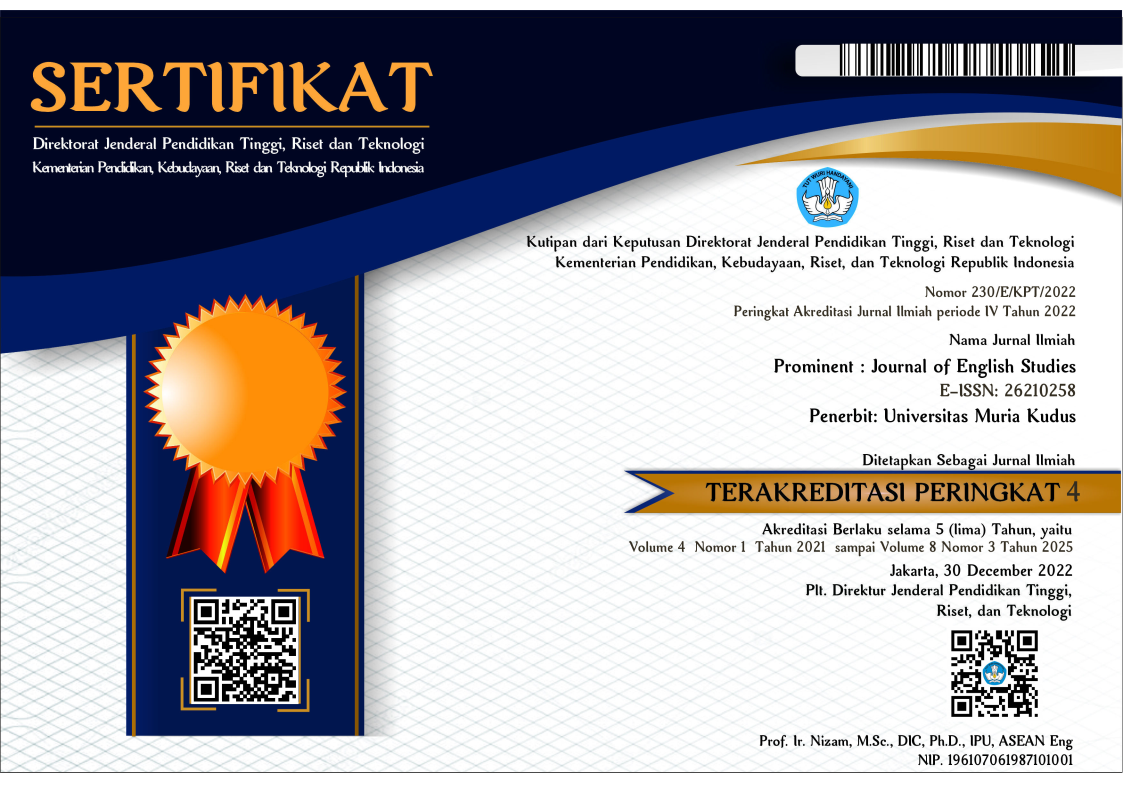TEACHER'S QUESTIONS OF THINKING SKILLS IN AN ENGLISH AS FOREIGN LANGUAGE CLASSROOM
Abstract
Keywords
Full Text:
PDFReferences
Adibah. (2011). An analysis of questions used by an English teacher in classroom (A case study at the 10th grade of SMA AL-YasiniPasuruan).
Alfari, Shabrina. (2018). Apa Itu Higher Order Thinking Skills (HOTS) yang Akan Ada di SBMPTN 2019? https://blog.ruangguru.com/apa-itu-higher-order-thinking-skills-hots-yang-akan-ada-di-sbmptn-2019.
Anderson, L. W. and Krathwohl, D. R., et al (Eds.) (2001). A Taxonomy for learning, Teaching, and Assessing: A Revision of Bloom’s Taxonomy of Educational Objectives. Allyn & Bacon. Boston, MA (Pearson Education Group).
Ardina, Ika. (2018). Apa itu Higher Order Thinking Skills (HOTS). https://beritagar.id/artikel/ gaya-hidup/apa-itu-higher-order-thinking-skills-hots.
Brock, C. A. (1986). The effects of referential questions on ESL classroom discourse. TESOL Quarterly, 20(1), 47-59.
Brown, H. D. (2007). Teaching by principles: an interactive approach to language pedagogy, 3rd ed. New York: Addison Wesley Longman.
Brown, H. D. (1994). Teaching by principles: An Interactive Approach to Language Pedagogy. New Jersey: Prentice Hail Regents, 169-171.
Chudron, Craig. (1998). Second Language Classroom-Research on Teaching and Learning. Los Angelas: Cambridge University Press.
Chung, B. M. (1994). The taxonomy in the Republic of Korea. In L. W. Anderson & L. A. Sosniak (Eds.), Bloom’s taxonomy: A forty-year retrospective, Ninety-third Yearbook of the National Society for the Study of Education (pp. 164-173). Chicago: University of Chicago Press.
Collier, Ellie. (2018). What is Effective Questioning & Why Should I Use it in My Classroom? https://www. highspeedtraining.co.uk/hub/what-is-effective-questioning/.
Cotton, K. (2003). Classroom questioning: school improvement research series. Portland, OR: Northwest Regional Educational Laboratory.
Krathwohl, David R. (2002). A Revision of Bloom’s Taxonomy: An Overview. Theory into Practice, (41)4), Autumn 2002, 2012-2018. The Ohio State University: Collage of Education. https://www.tandfonline.com/doi/abs/10.207/s15430421tip4104_2?Journal Code=htip20.
Prabowo, A.B, K.A. & Alfiyanti. (2013). An Analysis of Teachers’ Questioning Strategies During Interaction in the Classroom: A Case of the Eight Grade SMP PGRI 1 Semarang. ETERNAL (English Teaching Journal), 4 (1) January 2013, 40-53.
Pratama. (2015). Teacher and Learners’ Talk in the Classroom Interaction at Tenth Grade Students of SMA Jawahirul Hikmah Tulungagung in Academic Year 2014/2015. Thesis. Tulungagung: State Islamic Institute of Tulungagung.
Richards. Jack C. & Charles Lockhart. (1994). Reflective Teaching in Second Language Classroom. Cambridge: Cambridge University Press.
Richards, J. C., & Rodgers, T. S. (2002). Approaches and Methods in Language Teaching, 2nd ed. Cambridge: Cambridge University Press.
Rosyidah. (2018). An Analysis of Teacher’s Question Used in Classroom Interaction At 11th Grade of SMK Ma’aruf NU Prambon-Sidoarjo. Thesis. Universitas Islam Negri Sunan Ampel Surabaya.
Shomoossi, N. (2004). The Effect of Teachers’ Questioning Behavior on EFL Classroom Interactions. The Reading Matrix, 4,41-47.
Suk-a-nake, R., Heaton, S. L. Chantrupanth, D. & Rorex, P. D. (2003). The university EFL learners’ oral responses to various spoken question types. SLLT (12), 96-104.
Watson, Sue. (2019). High-Order Thinking Skills in Education: Teaching Students to Think Critically. https://www.thoughtco.com/high-order-thinking-skills-hots-education-111297.
Wilson, Leslie Owen. (2016). Anderson and Krathwohl – Bloom’s Taxonomy Revised: Understanding the New Version of Bloom’s Taxonomy. https://thesecondprinciple. com/teaching-essentials/beyond-bloom-cognitive-taxonomy-revised/.
DOI: https://doi.org/10.24176/pro.v5i1.6636
Refbacks
- There are currently no refbacks.
Prominent Journal of English Studies is licensed under a Creative Commons Attribution-ShareAlike 4.0 International License.
Dedicated to:

in Collaboration with APSPBI:





